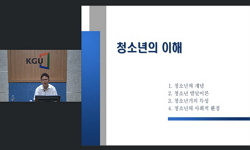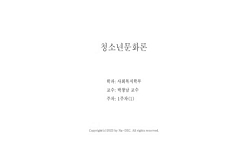The current study examined the unique contributions of cognitive and emotional variables to the subtypes of aggression(i.e., proactive-overt, proactive-relational, reactive-overt and reactive-relational) in sample of middle school students(N=319). Res...
http://chineseinput.net/에서 pinyin(병음)방식으로 중국어를 변환할 수 있습니다.
변환된 중국어를 복사하여 사용하시면 됩니다.
- 中文 을 입력하시려면 zhongwen을 입력하시고 space를누르시면됩니다.
- 北京 을 입력하시려면 beijing을 입력하시고 space를 누르시면 됩니다.

청소년의 공격성 하위 유형에 따른 인지 및 정서 특성 = The relationship between cognitive and emotional variables and subtypes of aggression in adolescents
한글로보기https://www.riss.kr/link?id=A104559983
- 저자
- 발행기관
- 학술지명
- 권호사항
-
발행연도
2012
-
작성언어
Korean
- 주제어
-
등재정보
KCI등재
-
자료형태
학술저널
- 발행기관 URL
-
수록면
227-250(24쪽)
-
KCI 피인용횟수
45
- 제공처
- 소장기관
-
0
상세조회 -
0
다운로드
부가정보
다국어 초록 (Multilingual Abstract)
The current study examined the unique contributions of cognitive and emotional variables to the subtypes of aggression(i.e., proactive-overt, proactive-relational, reactive-overt and reactive-relational) in sample of middle school students(N=319). Results showed that proactive-relational aggression was affected by obsession about others’ approval or favor, lower sensitiveness of unfair treatment, and higher tolerance for frustration. Next, higher trait anger and lower tolerance for frustration affected two types of reactive aggression. Finally, reactive-relational aggression was affected by lower tolerance for frustration and indifference about others’ approval or favor as well as higher hypersensitiveness of unfair treatment and high level of trait anger. Findings were discussed in terms of distinctions among four subtypes and treatment implications across types of aggression were also suggested.
국문 초록 (Abstract)
본 연구는 공격성의 하위 유형을 구분하는 인지 및 정서 특성을 확인하고자 하였다. 중학생 319명을 대상으로 성취에 대한 집착, 좌절에 대한 낮은 인내력, 무시나 부당한 대우에 대한 과민성...
본 연구는 공격성의 하위 유형을 구분하는 인지 및 정서 특성을 확인하고자 하였다. 중학생 319명을 대상으로 성취에 대한 집착, 좌절에 대한 낮은 인내력, 무시나 부당한 대우에 대한 과민성, 호감이나 인정에 대한 집착 등의 비합리적 신념과 특성분노, 정서인식 및 표현의 어려움, 역기능적 정서조절 등의 정서 특성이 주도-외현적 공격성, 주도-관계적 공격성, 반응-외현적 공격성, 반응-관계적 공격성에 미치는 영향을 알아보았다. 그 결과, 호감 및 인정에 대한 집착이 높고 무시나 부당한 대우에 과민한 경향성이 낮으며 좌절에 대해 높은 인내력을 가질수록 관계를 파괴하는 방식의 주도적인 공격성을 보이는 것으로 나타났다. 또한 분노를 쉽게 경험하고 좌절에 대한 인내력이 낮을수록 반응적인 공격성을 나타낼 수 있음을 보여주었다. 특히 분노를 경험하기 쉽고 좌절에 대한 인내력이 낮을 뿐 아니라, 인정에 집착하는 경향이 적고 무시나 부당 대우에 과민한 경우에는 반응-외현적 공격성보다는 반응-관계적 공격성을 보일 가능성이 높은 것으로 나타났다. 이를 바탕으로 시사점과 제한점을 살펴보고, 더 나아가 이에 따른 치료적 함의점에 대해 논의하였다.
참고문헌 (Reference)
1 전겸구, "한국판 STAXI 척도 개발 : 분노와 혈압" 2 (2): 60-78, 1997
2 김영숙, "학령기 아동의 정서인식 및 표현능력과 공격성 : 스트레스 대처행동의 매개 효과를 중심으로" 이화여자대학교 대학원 2009
3 이춘재, "학교에서의 집단 따돌림 : 실태와 특성" 집문당 2000
4 심주한, "초등학생의 공격성 유형에 따른 대인관계성향과 대인문제해결사고의 차이 분석" 한국교원대학교 교육대학원 2008
5 신희영, "초·중학생의 정서조절능력과 전략유형 연구" 서울대학교 대학원 2006
6 이영애, "청소년의 공격성 수준에 따른 공격행동유발경로의 구조분석" 한국청소년학회 9 (9): 87-112, 2002
7 한영경, "중학생의 관계적 공격성에 영향을 주는 개인 내적 요인" 아주대학교 대학원 2008
8 최은실, "정서인식 및 표현 능력 향상 프로그램의 효과연구" 이화여자대학교 대학원 2009
9 김지현, "아동의 공격성에 영향을 미치는 개인 내적?외적 요인에 대한 구조방정식 모형 검증" 한국아동학회 27 (27): 149-168, 2006
10 한유진, "상호작용 상황에서의 정서표현, 정서이해 및 정서조절 능력이 학령기 아동의 공격성 및 또래관계에 미치는 직·간접적 영향" 한국가정관리학회 24 (24): 1-16, 2006
1 전겸구, "한국판 STAXI 척도 개발 : 분노와 혈압" 2 (2): 60-78, 1997
2 김영숙, "학령기 아동의 정서인식 및 표현능력과 공격성 : 스트레스 대처행동의 매개 효과를 중심으로" 이화여자대학교 대학원 2009
3 이춘재, "학교에서의 집단 따돌림 : 실태와 특성" 집문당 2000
4 심주한, "초등학생의 공격성 유형에 따른 대인관계성향과 대인문제해결사고의 차이 분석" 한국교원대학교 교육대학원 2008
5 신희영, "초·중학생의 정서조절능력과 전략유형 연구" 서울대학교 대학원 2006
6 이영애, "청소년의 공격성 수준에 따른 공격행동유발경로의 구조분석" 한국청소년학회 9 (9): 87-112, 2002
7 한영경, "중학생의 관계적 공격성에 영향을 주는 개인 내적 요인" 아주대학교 대학원 2008
8 최은실, "정서인식 및 표현 능력 향상 프로그램의 효과연구" 이화여자대학교 대학원 2009
9 김지현, "아동의 공격성에 영향을 미치는 개인 내적?외적 요인에 대한 구조방정식 모형 검증" 한국아동학회 27 (27): 149-168, 2006
10 한유진, "상호작용 상황에서의 정서표현, 정서이해 및 정서조절 능력이 학령기 아동의 공격성 및 또래관계에 미치는 직·간접적 영향" 한국가정관리학회 24 (24): 1-16, 2006
11 이윤경, "분노조절 프로그램이 초등학교 저학년 아동의 공격성 감소에 미치는 효과" 연세대학교 교육대학원 2002
12 서수균, "분노와 관련된 인지적 요인과 그 치료적 함의" 서울대학교 대학원 2004
13 전선영, "반응적 및 주도적 공격성 아동의 사회정보처리와 행동 특징" 아주대학교 대학원 2000
14 박희경, "모에 대한 애착이 아동의 공격성에 미치는 영향 : 정서 변인들의 매개효과" 아주대학교 대학원 2008
15 정연희, "공격성향자들의 정서적 특징 : 부적 정서 사건에 대한 분노 반응을 중심으로" 서울대학교 대학원 2006
16 윤리라, "공격성의 유형에 따른 심리사회적 적응 및 사회정보처리 특성 : 반응적공격성과 비반응적공격성을 중심으로" 延世大學校 大學院 1998
17 Crick, N. R., "The role of overt aggression, relational aggression, and prosocial behavior in the prediction of children’s future social adjustment" 67 : 2317-2327, 1996
18 Eisenberg, N., "The relations of emotionality and regulation to children’s anger-related reactions" 65 (65): 109-128, 1994
19 Spielberger, C. D, "The experience, expression, and control of anger, In Health Psychology: Individual differences and stree" Spinger Verlag 89-108, 1988
20 Xie, H., "The development of social aggression and physical aggression : A narrative analysis of interpersonal conflicts" 28 : 341-355, 2002
21 Robin, S., "Systems conceptualization and treatment of anger" 55 : 325-337, 1999
22 Vitiello, B., "Subtypes of aggression and their relevance to child psychiatry" 36 (36): 307-315, 1997
23 Dodge, K. A., "Social-information processing factors in reactive and proactive aggression in children’s peer groups" 53 : 1146-1158, 1987
24 Schwartz, D., "Social-Cognitive and behavioral correlates of aggression and victimization in boys’ play groups" 26 (26): 431-440, 1998
25 Crick, N. R., "Social Information-Processing Mechanisms in reactive and proactive aggression" 67 : 993-1002, 1996
26 Crick, N. R., "Relational aggression, gender, and social-psychological adjustment" 66 (66): 710-722, 1995
27 Vitaro, F., "Reactively and proactively aggressive children : Antecedent and subsequent characteristics" 43 : 495-505, 2002
28 Dodge, K. A., "Reactive and proactive aggression in school children and psychiatrically impaired chronically assaultive youth" 106 (106): 37-51, 1997
29 Cornell, D. G., "Psychopathy in instrumental and reactive violent offenders" 64 : 783-790, 1996
30 Quay, H. C., "Psychopathological disorders of childhood" Wiley 1986
31 Smithmyer, C. M., "Proactive and reactive aggression in delinquent adolescents : Relations to aggression outcome expectancies" 29 : 86-93, 2000
32 Marsee, M. A., "Peer conflict scale. Unpublished rating scale" University of New Orleans 2004
33 Rothenberg, A., "On Anger" 128 : 454-460, 1971
34 Hubbard, J. A., "Observational, physiological, and self-report measures of children’'s anger : Relations to reactive versus proactive aggression" 73 (73): 1101-1118, 2002
35 Fanti, K. A., "Linking Callous-Unemotional traits to instrumental and non-instrumental forms of aggression" 10 : 2008
36 Penza-Clyve, S., "Initial Validation to the Emotion Expression Scale for Children(EESC)" 31 (31): 540-547, 2002
37 Prinstein, M. J., "Forms and functions of adolescent peer aggression associated with high levels of peer status" 49 : 310-342, 2003
38 Marsee, M. A., "Exploring the cognitive and emotional correlates to proactive and reactive aggression in a sample of detained girls" 35 : 969-981, 2007
39 Marsee, M. A., "Exploring the association between aggression and anxiety in youth : A look at aggressive subtypes, gender, and social cognition" 17 : 154-168, 2008
40 Bohnert, A. M., "Emotional competencies and aggressive behavior in school-age children" 31 : 79-91, 2003
41 Loukas, A., "Early adolescent social and overt aggression: Examining the roles of social anxiety and maternal psychological control" 34 (34): 335-345, 2005
42 Xu, Y., "Distinguishing Proactive and Reactive Aggression in Chinese children" 36 : 539-552, 2008
43 Little, T. D., "Disentangling the"whys"from the"whats"of aggressive behavior" 53 : 1431-1446, 2003
44 Bailey, C. A., "Differentiating forms and functions of aggression in emerging adults : Associations with the hostile attribution biases and normative beliefs" 37 : 713-722, 2008
45 Seah, S. L., "Differential correlates of reactive and proactive aggression in Asian adolescents : Relations to Narcissism, Anxiety, Schizotypal traits, and Peer Relations" 34 : 553-562, 2008
46 DiGiuseppe, R., "Development of a measure of rational/irrational thinking" 1988
47 Lento-Zwolinski, J., "College Students’ self-report of psychosocial factors in reactive forms of relational and physical aggression" 24 (24): 407-421, 2007
48 Frick, P. J., "Callous-unemotional traits and conduct problems in the prediction of conduct problem severity, aggression, and self report of delinquency" 31 : 457-470, 2003
49 Marsee, M. A., "Assessing aggression in at-risk youth using the Peer Conflict Scale: Confirmatory factor analysis and evaluation of factorial invariance across gender" 2007
50 Larsen, K. S., "Approval seeking, social cost and aggression : A scale and some dynamics" 94 : 3-11, 1976
51 Ramirez, J. M, "Aggression, and some related psychological constructs(anger, hostility, and impulsivity) some comments from a research project" 30 (30): 276-291, 2006
52 Connor, D. F., "Aggression and antisocial behavior in children and adolescents: research and treatment" The Guilford Press 2002
53 Martin, R., "A three-factor model of trait anger : Dimensions of affect, behavior, and cognition" 68 : 869-987, 2000
54 Novaco, R. W., "A stress inoculation approach to management in the training of law enforcement officers" 327-346, 1977
55 Phillips, K. F. V, "A new self-report measure of emotion regulation in adolescents: The Regulation of Emotions Questionnaire" 14 (14): 145-156, 2007
동일학술지(권/호) 다른 논문
-
Risk Factors for Child Maltreatment among Welfare Mothers
- 한국청소년학회
- 임인걸
- 2012
- KCI등재
-
- 한국청소년학회
- 문동규
- 2012
- KCI등재
-
초기 청소년기에 있는 아동의 지각된 부모양육태도 및 부모 간 양육태도 불일치와 사회불안 간의 관계
- 한국청소년학회
- 서경현
- 2012
- KCI등재
-
성별에 따른 초기 청소년의 우울에 어머니의 양육행동이 미치는 영향: 사회적 지지와 부정적 정서경험의 중재효과
- 한국청소년학회
- 최인숙
- 2012
- KCI등재
분석정보
인용정보 인용지수 설명보기
학술지 이력
| 연월일 | 이력구분 | 이력상세 | 등재구분 |
|---|---|---|---|
| 2027 | 평가예정 | 재인증평가 신청대상 (재인증) | |
| 2021-01-01 | 평가 | 등재학술지 유지 (재인증) |  |
| 2018-01-01 | 평가 | 등재학술지 유지 (등재유지) |  |
| 2015-01-01 | 평가 | 등재학술지 유지 (등재유지) |  |
| 2011-01-01 | 평가 | 등재학술지 유지 (등재유지) |  |
| 2009-01-01 | 평가 | 등재학술지 유지 (등재유지) |  |
| 2006-01-01 | 평가 | 등재학술지 선정 (등재후보2차) |  |
| 2005-01-01 | 평가 | 등재후보 1차 PASS (등재후보1차) |  |
| 2004-01-01 | 평가 | 등재후보 1차 FAIL (등재후보1차) |  |
| 2003-01-01 | 평가 | 등재후보학술지 유지 (등재후보1차) |  |
| 2002-01-01 | 평가 | 등재후보 1차 FAIL (등재후보1차) |  |
| 1999-07-01 | 평가 | 등재후보학술지 선정 (신규평가) |  |
학술지 인용정보
| 기준연도 | WOS-KCI 통합IF(2년) | KCIF(2년) | KCIF(3년) |
|---|---|---|---|
| 2016 | 2.14 | 2.14 | 2.17 |
| KCIF(4년) | KCIF(5년) | 중심성지수(3년) | 즉시성지수 |
| 2.34 | 2.47 | 2.766 | 0.54 |




 KISS
KISS







